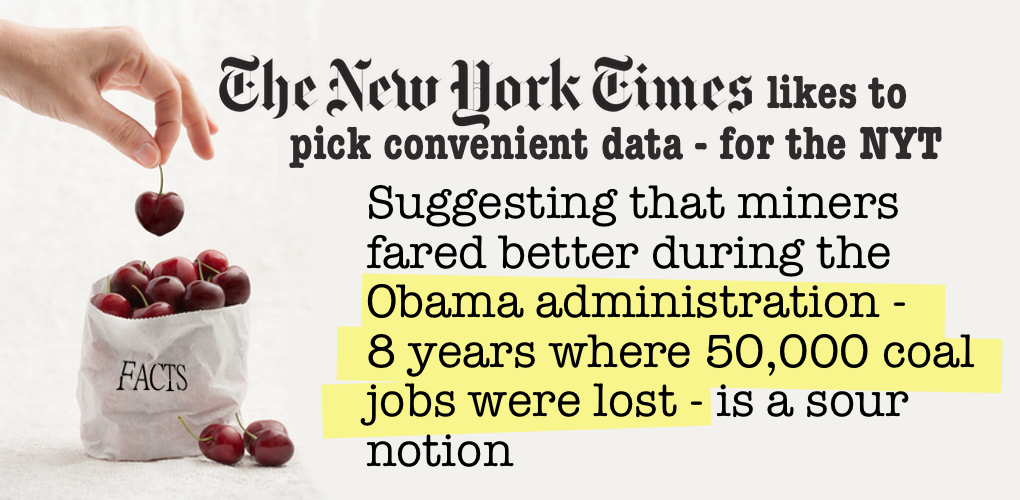
Missing the Mark, Again
This column has often highlighted The New York Times’ aggressive attempts to deify the prior administration, overlook facts and vilify coal. And The Times’ latest piece on the industry, the challenges it’s facing and the administration’s response, is no exception.
The Times was hardly the first outlet this election cycle to cover the subject, but it is likely the most prominent outlet to promote editorial comment as reporting.
The piece cherry picks data to further a narrative that the Trump administration has failed to deliver for miners, going as far to suggest that the industry fared better under the Obama administration. It’s an absurd conclusion, not least of which because coal employment data is very clear that before the pandemic, the Trump administration was able to halt a dramatic decline in coal employment that came during the Obama years.
When President Obama took office in 2008, mining employment stood at 134,000. At the end of his second term it plummeted to 81,000 – a nearly 40 percent decline. A loss of more than 50,000 American jobs under the Obama administration might not merit mention by The Times, but for countless communities upended by those losses, the pain was searingly real.
The closure of mines and the loss of tens-of-thousands of mining jobs under the Obama administration was directly related to polices designed to dismantle the industry.
Want proof? Under the Trump administration we’ve seen an almost impossible reversal prior to the pandemic. At the start of this administration, coal employment stood at just under 82,000. At the end of 2019, instead of the tens-of-thousands of jobs lost every year under the Obama administration, employment held at that same level: 82,000. Given The Times’ insistence that “It wasn’t Obama, it was the markets!” one might wonder how coal would have fared over the last four years under a Clinton administration had the election results been different.
Yes, The Times loves to cite cheap natural gas prices for the decline in coal. But if cheap gas is the key in this equation, not regulatory overreach, what happened to stop the job losses under the Trump administration prior to the pandemic? Did natural gas suddenly get more expensive? Nope.
Until the pandemic, which has slammed nearly every sector of the economy, the Trump administration’s efforts to level the playing field for all fuels was producing results.
Consider just one example: the Stream Protection Rule, which had nothing to do with protecting streams and everything to do with stopping coal mining. Rushed through at the end of the Obama administration, this 2,200-page rule was a win for bureaucracy and extreme anti-mining groups, and a loss for everyday Americans. If allowed to proceed, it would have made one half or more of total U.S. coal reserves impossible to mine. But the Trump administration overturned it in early 2017, saving tens of thousands of jobs that surely would have been lost under a Clinton administration that would have left the rule intact. Reversing regulatory overreach and giving the industry a chance to compete has clearly saved jobs.
Like so many other industries battling the unprecedented market conditions of the past six months, the coal industry is trying to navigate a new storm. On the other side lies the potential for considerable new challenges but also new opportunities. Rising natural gas prices, a potential global infrastructure push with booming steel demand, and an approaching new era of rising electricity demand driven by electrification are all dynamics worth watching.
Given a chance to compete, don’t count out the coal industry or coal power. The coal fleet remains the overlooked and undervalued foundation of the nation’s electricity grid, underpinning affordability, reliability and fuel security across the country. When coal generation comes to the rescue this winter to keep the lights on, let’s hope The New York Times can spare a few thousand words to tell that story. We know a few miners who’d like to help.
- On October 8, 2020
